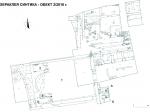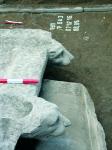Summary (English)
HERACLEA SINTICA (Lyudmil Vagalinski – lvagalin@techno-link.com) The Late Roman civil basilica was entirely excavated. During the Third Occupation Period, a kiln for glass production functioned in its northern barrel-vaulted room. Judging from the archaeomagnetic date, the kiln was fired for the last time during AD 303 – 354. A staircase in the southern barrel-vaulted room secured the access to the tribune in the apse of the basilica. A drain was explored beneath the room. The Third Occupation Period ended with a fire that occurred between AD 313 and 355. During the Fourth Occupation Period the floor levels were raised. Two cornices with sculptured lion’s heads-fountains and an architrave were discovered, collapsed in front of the southeastern corner of the basilica. A marble staircase was discovered, leading to the south towards the forum. The Fourth Occupation Period ended with an earthquake that occurred after AD 388, or after AD 402. The animal bones from the excavations were from oxen, pigs, sheep/goats, horses, dogs, rabbits, deer, chicken and geese. Carbonized timber from oak, elm, alder, Scots pine and plum tree or cherry tree was documented.
- Lyudmil Vagalinski - Archaeological Institute with Museum
Director
Team
Research Body
- Archaeological Institute with Museum






![Download [PDF]](/excavation/skins/fasti/images/results/download_sml.png)
